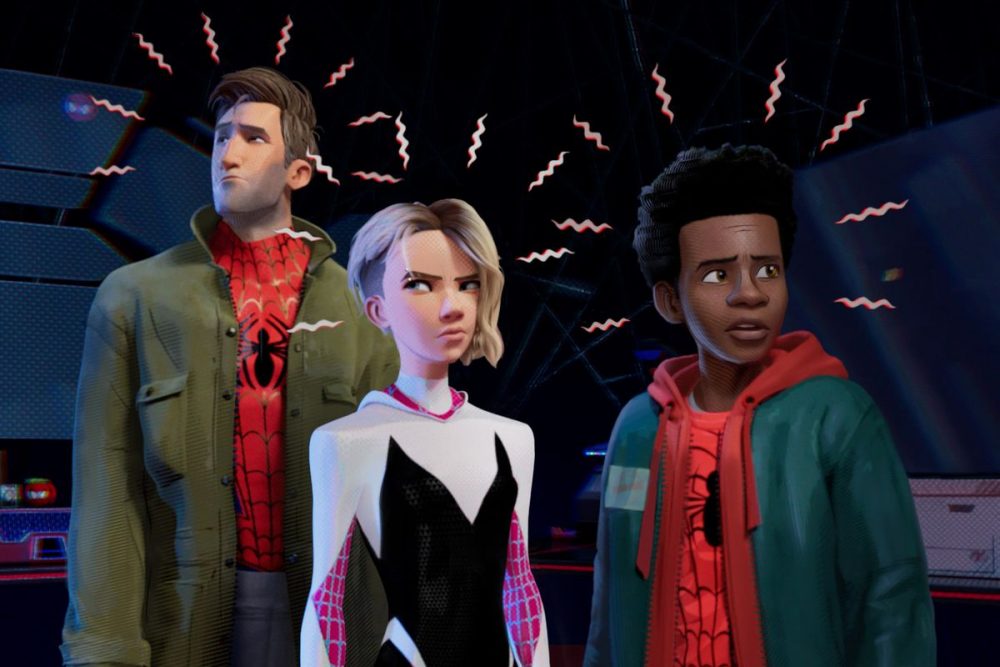I’ll be the first to admit that I’m not a die-hard devotee of any of the Spider-Man franchises, so perhaps take my headline with that grain of salt, but I definitely have a new favorite Spider-Man movie. And that’s not a jab at all the other films: it’s just a testament to how original and refreshing Spider-Man: Into the Spider-Verse really is. In his cinematic debut, Miles Morales inherits the heavy responsibility of squaring off against Kingpin, who builds a machine that threatens to tear the city inside-out. But, hey, that’s not all! Six more Spider-People and several more villains later, we somehow end up with one of the most unique, emotional, and gorgeous superhero films I’ve seen in quite some time. Here are a few of the reasons I enjoyed it so much.
1. Teambuilding 101
Remember when Marvel decided to slowly build up its team over the course of more than a dozen movies? And then DC decided to do the exact opposite and lead with Batman v. Superman to an immediate Justice League film? I think the aftermath of those decisions led many to believe that Marvel’s route was the most effective path: a slow build-up that gives each character its own introduction and space to breathe. But Spider-Man: Into the Spider-Verse is proof positive that the immediate team-up and shared universe introduction can work beautifully if it’s handled correctly. It’s an impressive feat to take seven superheroes, only a few of which are well known to general audiences, and produce one movie introducing them all that doesn’t feel drastically undercooked. The script handles this by choosing its focal points, making Miles Morales (Shameik Moore) the film’s clear protagonist with a full-on origin story, giving supporting roles to Spider-Gwen (Hailee Steinfeld) and Spider-Man from an alternate reality (Jake Johnson), and then more minor parts to Spider-Ham (John Mulaney), Spider-Man Noir (Nicolas Cage), and Peni Parker (Kimiko Glenn). The film also manages to give us several villains on top of that, and still nothing feels particularly rushed.
2. A Happy Medium
What I loved so much about this movie is how it used its animated medium as an advantage over live action films instead of a substitute for them. Spider-Verse looks more like a gorgeous comic than a reproduction of a live action film. There are bright colors palettes, distinct design choices, and overall visual effects that would be impossible to successfully duplicate with CGI. There are plenty of animated superhero movies out there, but some fall into the trap of looking like animated versions of exactly what you’d see play out in a live context: throwing punches, knocking down buildings, you get the idea. So much of what’s seen in Spider-Verse goes far beyond that and would look like garbage in a live-action context, with the animation giving the creators an edge and more freedom to go big with the ideas.
3. A Matter of Perspective
We’ve had six live-action movies across three franchises about Peter Parker. His origin is so ubiquitous, it’s a running joke in Spider-Verse. Introducing other characters in this universe is a massive and needed step for the franchise. Devotees will still get their fill of Parker, but centering the story on Morales and introducing six other alternate-reality versions of Spider-Man is what really sets this film apart. Being white, a man, being young, from recent times – in all of the live action Spider-Man movies we’ve had so far, the protagonist’s perspective has never changed. But Spider-Man, in this film, doesn’t even have to be human. Spider-Man changes across his or her iterations in alternate universes, which gives the character and movie a much broader perspective for audiences to identify with. And even across those broad perspectives, the film manages to hone in on the core traits that bond every version of the character, like unrelenting perseverance in the face of bad fortune.
4. Striking a Balance
What perhaps surprised me most about Spider-Verse was its approach to tone. How would I characterize it to someone else? Funny? Tragic? Self-aware? Silly? It might sound like it’s all over the place, on paper, but the fact that I can’t pigeonhole how this movie feels is a testament to the complexity of the script. The most immediate comparison I can think of is The Lego Movie, which was helmed by much of the same creative team. But even with the similarities in the way they don’t take themselves too seriously, make plenty of pop culture references, and so on, the film takes the tonal flexibility to another level. Spider-Verse achieves comedy and tragedy in equal measure; it’s not just a comedy that has a few serious moments to achieve a sense of urgency. Because another trait that binds the many iterations of Spider-Man in this universe is how anchored they are to tragedy and loss, and this film doesn’t let us forget that.
5. That Post-Credits Scene
Really, I’m not going to say anything else about this one, because that would ruin it. But definitely stick around until after the credits. The film goes out on the perfect note.










Why do I get the feeling that if they were to come out with a male version of “Buffy the Vampire Slayer,” the reaction to that would be just a TINY bit different than to this intellectually vacuous strip mining of Spider-Man?
Mike
Nobody tell Mike about Supergirl.
“Nobody tell Mike about Supergirl.”
Did they kill off Superman or Superboy to make way for Supergirl? Did Supergirl ever replace the other two? Does no one remember that one of the whole justifications for CRISIS ON INFINITE EARTHS was to get rid of the intellectually vacuous strip mining of the DC Universe?
And this isn’t even like the umpteen Super- and Bat-characters that again populate DC comics. At least those are DIFFERENT CHARACTERS. SuperGIRL. BatWOMAN. This is mostly just Spider-MAN over and over again.
Mike
No, they just killed off Superman to replace him with four different “strip-mined” versions of him, including a POC…and people call that one of the best Superman stories ever.
You realize Miles Morales and Spider-Gwen are totally different characters from Peter Parker, right? You understand how the multiverse concept works, right? Honestly, I’m confused what you’re mad about here. Peter Parker is in the movie.
And in classic moving the goalposts fashion, an argument that started with gender suddenly became an argument about “intellectually vacuous strip mining.”
Peter Parker isn’t dead outside the Ultimate universe — though he would be in his early 70s if he were a real person, having graduated from high school in 1965.
Abraham Riesman wrote a long account of the Ultimate universe for Vulture a few years ago. He describes Bendis’ thinking in creating Miles Morales:
“If a middle-class teenager was growing up deep in Queens in 1962, sure, he’d be white. But in the New York of 2011’s profoundly multiethnic outer boroughs? Statistically, he’d almost certainly be a person of color.”
I have no problem with these characters co-existing. Just see the movie, Mike, then let us know what you think.
“intellectually vacuous strip mining of Spider-Man”. Replace Spider-Man with any other character and that’s pretty much the main existence to both DC and Marvel. Sometimes this mining of characters works out and other times it doesn’t. The fact that this movie is getting stellar reviews currently at 100% at Rotten Tomatoes, it looks like this time it has worked out.
I personally, think that a lot of the possibilities for these decades old characters has really been exhausted. Putting a new character into the helm of one of these old superheroes makes things a lot more interesting. So it doesn’t surprise me that a movie starting Miles Morales is a refreshing new take on the character in a movie.
Comments are closed.